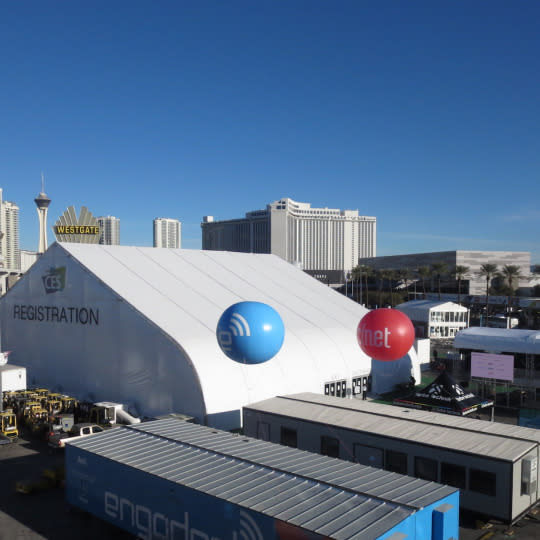What Is CES, Anyway? A Quick Guide for the Perplexed

(Photo by Rob Pegoraro/Yahoo Tech)
This week, 170,000 or so people will descend on Las Vegas, but they will forgo most of the usual Sin City vices in order to spend way too much time in convention centers and other exhibit spaces. What would possess so many people to do such a thing? Three letters: C. E. S.
What is this thing?
CES — originally an abbreviation for the Consumer Electronics Show when it debuted in 1967, but which is now a name unto itself — is a convention that draws the population of a small city every year. It’s organized and run by the Consumer Technology Association, an Arlington, Va.-based trade group.
Who shows up?
CES reels in not just gadget manufacturers but also numerous other ancillary business folks: retailers, software developers, advertisers and marketers, Hollywood types, and government officials, not to mention thousands of journalists who are all ahead of you in some endless line to get into a press conference.
Last year, according to the CTA’s audited report, there were 176,676 total attendees. Of those, almost a third were people in advertising or marketing (26,587) or entertainment and content (26,950). Fun fact: Amazon alone sent 507 representatives to the show. 48,833 came from outside the U.S.; China alone sent 27 separate delegations.
What do they actually do?
The show starts with a long lineup of press conferences, followed by a series of keynote addresses and panel discussions. You could spend the entire show going from one such event to another — except that’d leave little time to browse the more-than-2-million square feet of exhibit space. Sadly, you can’t hope to see all of that, either, because it’s spread out among the Las Vegas Convention Center, the Sands Expo Center, and various other venues spread up and down the Strip.
CES evenings feature a rich banquet of receptions and dinners. Clean living all around!
When does it happen?
CES officially runs from January 6 to January 9. I fly out two days prior — and many other attendees will have beaten me there. That’s because, while Monday features a handful of pregame events, today (Tuesday) is press-conference day.
Why early January? The original idea was to give retailers a chance to see the fall lineup of gadgets when they still had the lessons of holiday sales fresh in their minds. That schedule has stuck even as product cycles have become less fixed. Now the show has become an immovable object — much as many of us might wish that CES didn’t follow so closely after the holidays.
”Early January is the only time-slot that works for the load in,” said Jeff Joseph, CTA’s vice president for communications, adding that exhibitors need several weeks to set up their outposts on the show floor.
Why Vegas?
For many years, CES took place in Chicago. (It also featured a second, summer edition that fizzled out in the mid 1990s.) But while Chicago also has a large convention center and thousands of hotel rooms, it suffers from one issue absent in Vegas: “The weather is not conducive to a January show,” CTA spokesman Jim Barry said in a bit of understatement.
CES regularly strains the lodging and transportation capacity of Vegas, but it’s not going anywhere. The show’s About Us page lists event dates through 2020, and I don’t know why I haven’t accepted the inevitable and put all of them on my calendar.
Why should I care?
The overdose of hype that accompanies the show — and the way some high-profile CES debuts either face-plant in the market or never even hit stores — could lead you to wonder why there’s all the fuss.
“CES is annually filled with we-could-do-it-so-we-did-it products that seem cool technologically on the surface but don’t actually help accomplish or solve anything,” observed journalist Stewart Wolpin, who’s attended every CES from 1984 on. On the other hand, he added, “not every breakthrough as we later came to know it was even noticed at the show.”
The important thing about CES is that it’s one of the few times when almost the entire electronics industry (Apple excluded) comes together to show what they’re working on. Read the coverage with an eye towards patterns and trends, and you can get a better sense of what you’re likely to see in stores nine months later.
Or as telecom analyst Gary Arlen, a veteran of 30 or so shows, said: “When we see many companies with similar products, suddenly that’s important.”
Not every CES trend will result in products that people want to buy — who can forget how big 3-D TV was at 2010’s CES. But, if nothing else, seeing the industry line up to sell you a particular upgrade often means less-glamorous versions of the same product are about to get a whole lot cheaper.
Email Rob at rob@robpegoraro.com; follow him on Twitter at @robpegoraro.

